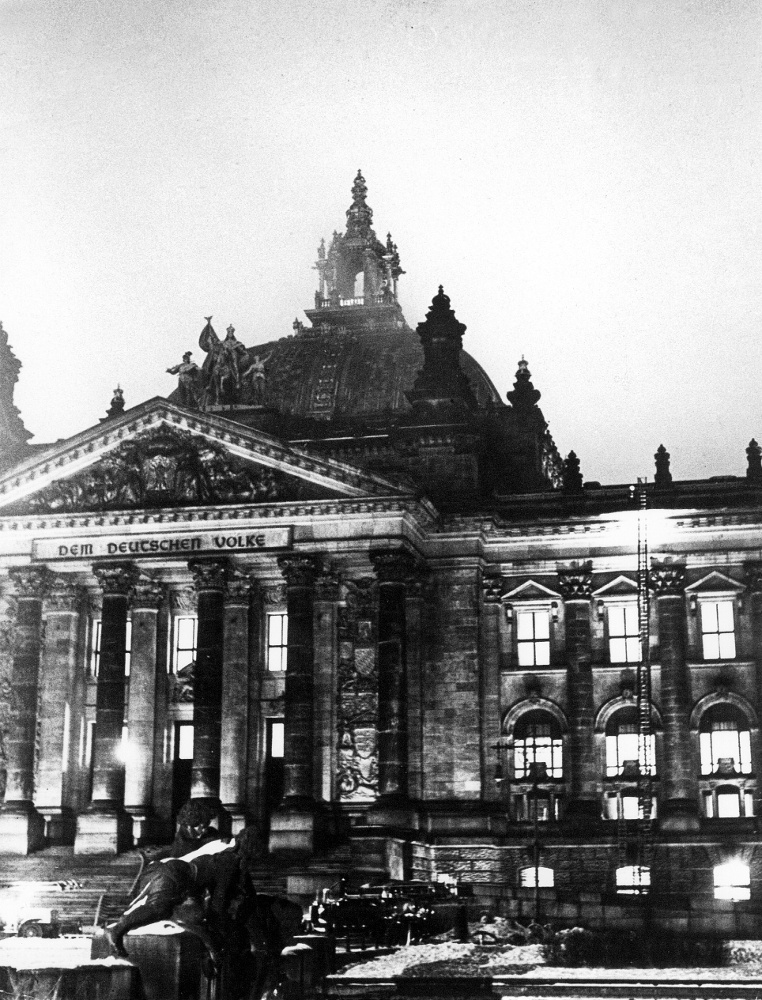Am Abend des 27.2.1933, vier Wochen nach der Ernennung Hitlers zum Reichskanzler und inmitten des Wahlkampfs vor den Reichstagswahlen vom 5.3.1933, brannte das Parlamentsgebäude in der Reichshauptstadt, der Deutsche Reichstag. Mehrere entdeckte Brandherde verwiesen sofort auf eine Brandstiftung. Noch am selben Abend wurde im Reichstag der niederländische Maurer und Linksanarchist Marinus van der Lubbe festgenommen, der ein Geständnis ablegte. Er nannte als Motiv, einen Aufstand der deutschen Arbeiterschaft gegen die Hitlerregierung beabsichtigt zu haben. Die Nationalsozialisten gaben sich überzeugt, dass van der Lubbe im Auftrag kommunistischer Organisationen gehandelt habe und die Tat die Initialzündung zu einem kommunistischen Aufstand darstellen sollte, was jedoch bis heute nicht belegbar ist und als äußerst unwahrscheinlich gilt. Auch die von manchen Zeitgenossen und Historikern vertretene These von einer nationalsozialistischen Täterschaft kann letztlich nicht schlüssig nachgewiesen werden; aber auch an der Alleintäterschaft Lubbes werden immer wieder Zweifel geäußert.
Das NS-Regime instrumentalisierte den Brandanschlag unmittelbar zur Bekämpfung von Gegnern aus dem Arbeitermilieu und zur Beseitigung demokratischer Verfassungselemente, also zum Ausbau der Diktatur. Bereits am nächsten Tag bestätigte das Kabinett und unterschrieb Reichspräsident Paul von Hindenburg die von Innenminister Wilhelm Frick vorgelegte Verordnung zum Schutz von Volk und Staat, auch ‚Reichstagsbrandverordnung‘ genannt, die mit der „Abwehr kommunistischer staatsgefährdender Gewaltakte“ begründet wurde. Rechtsgrundlage war Artikel 48 (2) der Weimarer Reichsverfassung („Wiederherstellung der öffentlichen Sicherheit und Ordnung“). Die Reichstagsbrandverordnung setzte die zentralen, verfassungsmäßig garantierten Grundrechte außer Kraft: Freiheit der Person, Unverletzbarkeit der Wohnung, Brief- und Fernsprechgeheimnis, Meinungs-, Presse- und Versammlungsfreiheit, Vereinigungsrecht und die Gewährleistung des Eigentums. Zudem wurde die Reichsregierung ermächtigt, in den einzelnen Ländern vorübergehend die Macht zu übernehmen. Auch wurde für zahlreiche Straftatbestände, die zum Teil erstmals definiert wurden, die Todesstrafe eingeführt.
Wesentlich war in den folgenden Wochen zum einen die einsetzende Verfolgung von Tausenden Kommunisten und Sozialdemokraten, die ohne Anklage und gerichtliche Kontrolle von Polizei und zur Hilfspolizei ermächtigten SA in ‚Schutzhaft‘ genommen wurden. Zum anderen diente die Reichstagsbrandverordnung als Instrument zur Ersetzung demokratisch gewählter Regierungen durch nationalsozialistische Länderkabinette. Bis zum Ende des Dritten Reiches setzte die Verordnung die in der formal noch gültigen Weimarer Verfassung verankerten Grundrechte außer Kraft und etablierte damit den permanenten zivilen Ausnahmezustand.


